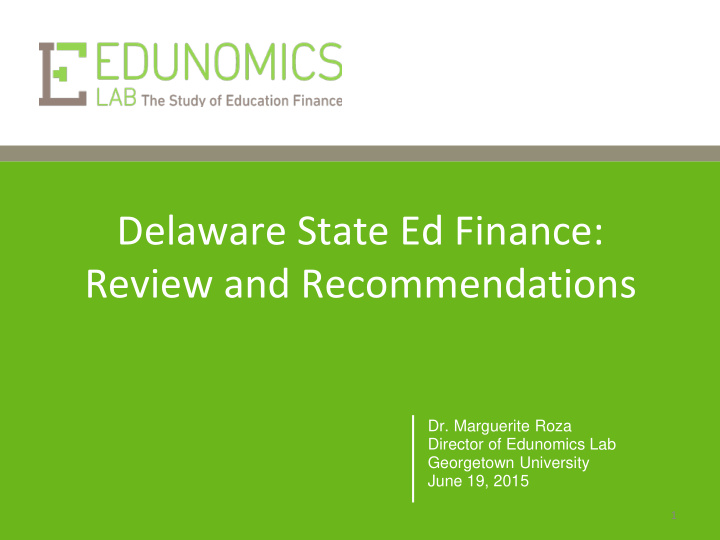



Delaware State Ed Finance: Review and Recommendations Dr. Marguerite Roza Director of Edunomics Lab Georgetown University June 19, 2015 1
Why change the formula? 1. Provide equity for students – Students with higher needs ought to receive higher dollar amounts. And students with equal needs should have access to equal dollars regardless of where they are served. The state allocation system should adjust for student need, ensure equity across student types, and factor in local revenues to ensure equal access to total funding. 2. Delivery models are changing and the formula must not stand in the way – Where formulas focus on students (not delivery models) and are flexible, those formulas can remain in place even as schooling delivery models change over time. Also, state funding formulas should be structured so as to ensure ample resources over time (meaning that they should tap local monies which are more sufficient in the long run). 3. Be simple and transparent – A simple formula provide districts with a predictable, understandable revenue stream that can be summarized on a single page. School personnel should understand how much money comes with each student type in order to be able to link spending with outcomes. 4. Be outcome-focused – Students benefit when districts and schools take ownership to seek the greatest outcomes possible with the funds they have. Formulas should promote innovation and productivity, encourage student growth in learning, and support continuous improvement even as new delivery models yield greater outcomes. EDUNOMICS LAB AT GEORGETOWN UNIVERSITY 2 EDUNOMICS.GEORGETOWN.EDU
How much money is available in Delaware for public schooling from fed, state, & local sources? (Figures represent state-wide averages with increments by student type) Base $10,606 All Students BUT, actual spending by Low-Income $834 district and school varies SpEd PreK-3 $5,886 enormously from these averages. SpEd Basic $10,749 SpEd Intensive $13,698 SpEd Complex $29,317 VoTech $7,388 $0 $5,000 $10,000 $15,000 $20,000 $25,000 $30,000 EDUNOMICS LAB AT GEORGETOWN UNIVERSITY *Note that no added funding is available for ELL students. 3 EDUNOMICS.GEORGETOWN.EDU
Inequity: The current system directs more of its limited dollars to some districts/students at the expense of others. Total Federal, State, and Local Revenue Per Pupil $19,504 $20,000 $18,000 $16,000 Highest $14,000 spending $13,247 Statewide average school $12,000 Highest Lowest revenue $10,019 revenue $10,000 district district Lowest $8,000 spending school EDUNOMICS LAB AT GEORGETOWN UNIVERSITY 4 EDUNOMICS.GEORGETOWN.EDU
Even non-targeted funds are delivered in ways that shortchange some districts/students.* Total Non-Targeted Revenue Per Pupil $14,805 $15,000 More districts are losing than Some districts $14,000 winning with the current spend $2-3000 model, than if existing funds less per pupil $13,000 were distributed via student- than the average. based formula. $12,000 Highest spending $11,000 school Statewide average $10,343 $10,000 Highest Lowest revenue $9,000 revenue district district $8,000 $7,476 Lowest spending $7,000 school *Non-targeted funds exclude monies earmarked for students in poverty, with disability, or lacking English proficiency. EDUNOMICS LAB AT GEORGETOWN UNIVERSITY 5 EDUNOMICS.GEORGETOWN.EDU
Relative to other states Delaware allocates a smaller share of its funds on the basis of students. 6
Why upset the apple cart with a new formula? Improve equity, and deliver better outcomes with existing funds Poor Relationship Between Spending and Outcomes 100% 90% % Proficient in 3 rd Grade Math 80% 70% 60% 50% 40% 30% Yellow diamonds are charter schools. 20% $7,000 $8,000 $9,000 $10,000 $11,000 $12,000 $13,000 $14,000 $15,000 $16,000 $17,000 School Expenditure Per Pupil EDUNOMICS LAB AT GEORGETOWN UNIVERSITY EDUNOMICS.GEORGETOWN.EDU 7
Previous Summary of our Recommendations 1. Allocate funds per pupil using a student-based allocation formula. 2. Ensure funds delivered are flexible so as to transfer ownership over the relationship between spending and outcomes to local leaders. Ensure that constraints on delivery (such as salary schedules) do not have the effect of interfering with distribution of dollars (and dollar equity). 3. Restructure equalization funding (to tap and time local money): Count funds raised from some minimum effort (say, 10 mills) toward • each district’s student allocation (with state funds making up the difference). Guarantee districts a certain revenue for an additional given tax effort • (e.g. $3,000 per pupil per 10 mil levy). 4. Build a transparency system that measures actual spending and outcomes by school to help drive productivity gains. EDUNOMICS LAB AT GEORGETOWN UNIVERSITY 8 EDUNOMICS.GEORGETOWN.EDU
Recent changes in federal law ESSA replaces NCLB and carries three implications for DE funding formula: 1. Changes in Title I “Supplement, not supplant” requirement : Title I funds must layer on top of equitable distribution of state/local funds. New guidance forthcoming, but anticipate a requirement that allocation of state and local funds must be equitable across schools by poverty quartile. Currently, DE’s formula stands in the way of districts delivering funds equitably to schools. 2. WSF pilot option: Districts can apply for additional Title I flexibility if they demonstrate delivering state/local funds to schools via weighted student formula. Under DE’s formula, no district can qualify. 3. New requirement for financial transparency to school level : School report cards will be required to report total spending by school, thereby showcasing current spending inequities across schools. EDUNOMICS LAB AT GEORGETOWN UNIVERSITY 9 EDUNOMICS.GEORGETOWN.EDU
Two WSF implementation options (to reduce disruption) Option A: Replace old formula with a state-wide SBA formula with “hold harmless” provisions – CA used this model and set aside some funds to offset losses for some districts. The CA hold harmless funds phase out over 5 years. Option B: Pass a new formula to be used only by districts wanting to opt in. (Others would remain on a frozen unit based system indefinitely, until they too wanted to opt in). GA used a version of this model. More adept superintendents (and those with more financial upside) will likely move first. The early adopters normalize the student-based funding system and create expectations for that same flexibility/equity among others. EDUNOMICS LAB AT GEORGETOWN UNIVERSITY 10 EDUNOMICS.GEORGETOWN.EDU
Recommend
More recommend